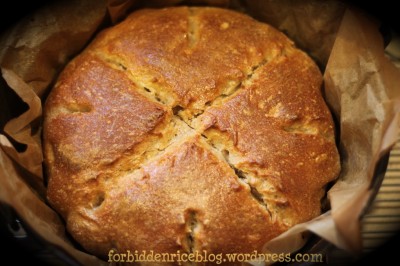
In my last post, I left off with a fourth day starter feeding. At this point (two more days in) I’ve been feeding my starter twice a day. Once in the morning, once in the early evening. Each feeding consists of 1 cup of unbleached flour, ¾ cup warm (85º F) water.
At this point, bubbly and beer-smelling, the starter is ready to be put to use. I opted for a loaf of rustic sourdough bread yesterday, based a recipe from Cat, of Neo-Homesteading. The bread came out perfectly crusty on the outside, moist and soft of the inside. I was disappointed in the taste, which has nothing to do with the recipe and everything to do with my fermenting.
Turns out if you leave your starter on the countertop, eventually feeding it twice a day, 5 days still isn’t enough to produce a starter “ripe” enough for baking. It’ll work, but the taste won’t be as developed. I’m hoping that allowing the starter to ripen longer before my next baking attempt will produce a more sourdough-like taste.
The starter can be left out, so long as it is fed regularly. But at this point, if you don’t intend to feed it daily, keep the starter refrigerated. If refrigerated, you’ll want to feed the dough 1 cup of unbleached flour and ¾ cup warm (85º F) water once a week. When baking, remove the desired amount of starter then replenish what you’ve removed with equal weighted parts of water and flour.
The following recipe is what I used for my first loaf of sourdough bread. I’ve often had trouble with homemade bread being too dense, or consistently too crusty both on the outside and inside. This worked out perfectly.
Dutch Oven Sourdough Bread
based on a recipe by Cat Morrow
Ingredients:
1 cup sourdough starter
1½ cups warm water (100-115º F)
3 cups unbleached flour
1 cup whole wheat flour
2 tsp. sea salt *
* I completely forgot to add the salt to my dry ingredients before I already had my dough going. I decided to forego the salt, just to experiment. The bread still had a great taste, so while the original recipe called for salt, I’ll leave it up to you to decide how much you’d like to incorporate.
Directions:
In a bowl, combine the sourdough starter and warm water, stirring until combined. Add 1 cup of the unbleached flour and the salt, if you’re using it. Slowly add in the remaining unbleached and whole wheat flour, adding more or less flour as needed (the original recipe called for 2 cups unbleached flour, but I found I needed at least another cup plus more while kneading to create a ball of dough).
Knead the dough on a lightly floured surface for about 10 minutes, until you have a smooth and almost elastic-like ball of dough. Place in a lightly greased bowl, turning once to get both sides of the dough covered in oil. Cover loosely with cling wrap, then let the dough rise until doubled in size (timing depends on your climate; it took my dough about an 1½ hours).
Once the dough has doubled in size, punch it down and shape it into a ball by first folding in the edges, then turning the dough over and working it into a smooth ball. Transfer the dough to a lightly floured piece of parchment paper. Allow the dough to rest 30-45 more minutes.
Preheat the oven to 450º F with the dutch oven in the oven, allowing it to preheat as well.
When it’s time to bake your bread, quickly transfer the piece of parchment paper holding the dough ball into your dutch oven. Score the top of your dough as you like. Slightly dampen the lid of your dutch oven, then cover the pot and place in oven. Bake for 20 minutes with the lid on. After 20 minutes, remove the lid and bake for an additional 20-25 minutes.
Once the crust is your desired color, remove the bread from your oven and allow it to cool. Enjoy!





Pingback: Sourdough Doughnuts with Vanilla Bean Glaze | Forbidden Rice Blog